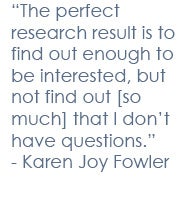Above, watch the full Winter Words session of a conversation on the creative writing process with authors Karen Joy Fowler and Carole DeSanti.
In fiction writing, how does imagination complement research and vice versa? And how do authors’ personal histories fit into that? At a recent Aspen Writers’ Foundation Winter Words event, award-winning author Karen Joy Fowler and acclaimed debut novelist and editor Carole DeSanti shed some light on those parts of the creative process while discussing their most recent novels.
“[I’ve learned] nothing is too preposterous in this world,” said Fowler, whose latest novel “We Are All Completely Beside Ourselves” is about a girl who is raised alongside a chimpanzee. The basis of her novel is fact. A psychology professor, who was a colleague of Fowler’s father, conducted an experiment by raising his child alongside a chimpanzee, standardizing their upbringing to see what the results would be. Fowler said that she’s drawn to such kinds of odd news, and wished to tell the story from the point of view of the child. During her research she found a lot of information about experimental chimps, yet there was nothing about the children who grew up in houses with them.
“That gives me permission to make up what I need to make up,” said Fowler, adding that creating her main character, Rosemary Cooke, was the most fun part of the imaginative journey.
“The perfect research result is to find out enough to be interested, but not find out [so much] that I don’t have questions,” she said. “So I write through my questions and perplexities.”
DeSanti, whose debut novel “The Unruly Passions of Eugénie R.” takes place in 1870s Paris, said that her research supported her imagination. She immersed herself in the period with tactile objects — looking at umbrellas at textile museums and going through documents from the era, for example.
 “I realized I was writing about a world I knew very well,” said DeSanti, who is also a longtime editor at Penguin pubishing group. “I felt so at home in that world that my confidence level was really boosted by it.”
“I realized I was writing about a world I knew very well,” said DeSanti, who is also a longtime editor at Penguin pubishing group. “I felt so at home in that world that my confidence level was really boosted by it.”
But her imagination only kicked into high gear when she was able to let go of her inner editor’s desire to be in control. She told the story of how a male character, a former lover of Eugénie’s, insisted on being more a part of the book than DeSanti wanted him to be. Although DeSanti had no intention of having the man be anything more than a background figure, she ended up letting go and listening to his voice.
“There was a rush about the whole thing,” she said. “It’s a magical process to allow what was on the other side to reach through the computer screen and take me by the hand and say, ‘You’re not in control anymore.’”
Asked about the emotional quality found in her work, Fowler said her first impulse was to attribute it to her own personal history. Her family had moved from Bloomington, Indiana, (where “Beside Ourselves” is set) to California when she was 11 years old, and she’s lived there ever since. But she made Bloomington out to be “like a kind of Oz,” and her novel, she admitted, is “in some very deep way” about her relationship with her father.
“My childhood works in my writing in a way that feels magical to me,” Fowler added. “It is a source of that imagination, that imagery, that when I talk about it, when people ask me which parts actually happened and I try to answer that question, I feel the whole subject, the work becoming less magical.”
DeSanti explained that even having spent most of her career as an editor, she had to work hard to not only become a writer but to trust her own creative process. She worked on “Unruly Passions” clandestinely for a decade, she said, throwing out many drafts and at times doubting both her ability and the work itself. Part of what the novel is about, she said, is exploring how a woman learns to doubt herself.
Asked to elaborate, DeSanti said, “doubt is such a fascinating subject. You can’t think about it too much or you’ll begin to doubt you can do anything. It’s like an infectious disease.”
But in her case, DeSanti’s hope returned when her eye fell on a passage she had written that she later found interesting.
“There’s something about writing itself that has to rekindle your interest,” she said. “It’s like growing a plant. I had to turn myself from someone who had been creatively starved into someone who knew how to put the nutrients back in and cultivate that little plant.”
